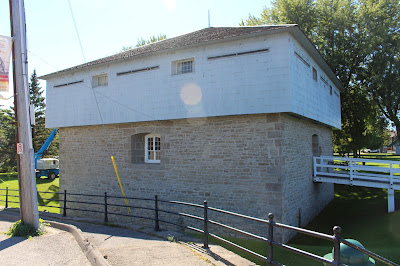The Merrickville Blockhouse stands on the northwest corner of Main Street West and St. Lawrence Street in Merrickville, Ontario.
"The Merrickville blockhouse is one of four blockhouses constructed on the Rideau Canal. Its architecture is a typical design utilized throughout British North America. The 3.5 foot (1.6 metres) walls were designed to be strong enough to withstand small canon fire with a pyramidal tin sheathed roof to withstand torching. The impressive stone lower half of the building measures 50-foot square (15.2 metres square) making it the largest blockhouse on the Rideau Canal. The upper level overhang derived from medieval fortifications, allows for machicolated defence (holes cut in the overhang allowing for downward fire on an enemy). The loopholes cut in each hewn square timber wall are long and narrow but tapered within allowing the defender a greater angle of fire.
"Originally, small defensible lockmasters houses, such as those constructed at various lock stations on the Rideau Canal, were to be built; however, Lieutenant Colonel John By, the Royal Engineer in charge of the construction of the Rideau Canal, thought these insufficient. Lt. Col. By's proposal for 22 large blockhouses was rejected by the Board of Ordnance because of the exhorbitant cost. In 1831 Lt. Col. By of his own accord started construction of four blockhouses, that were completed by 1833.
"The Merrickville blockhouse was a primary concern to Lt. Col. By when the province began to upgrade the Prescott road decreasing the wilderness buffer zone between Canada and the United States. The defensible building could staff 50 men in the barracks area while the lower stone half could house ordnance, arms and ammunition. The building designed to defend the Rideau Canal from American aggression was never permanently staffed by the military, although during 1837 Upper Canada Rebellion the 34th Regiment briefly took residence while enroute to Fort Malden."
"Le blockhaus de Merrickville est l'un des quatre bâtiments du genre égrigés le long du canal Rideau, selon un design architectural utilisé dans toute l'Amerique du Nord britannique. Les Murs mesurent plus d'un mètre d'épaisseur (3,5 pieds) et sont assez solides pour résister au tir de petites pièces d'artillerie; le toit de tôle pyramidal est conçu pour résister aux tirs incendiaires. La partie inférieure de l'imposant bâtiment est en pierre; elle mesure plus the 15 mètres carrés (50 pieds carrés), ce qui en fait le mâchicoulis (ouvertures permettant de soumettre un ennemi à un tir orienté vers le bas). Les meurtrières percées dans chacun des murs de bois équarri, bien qui longues et étroites, vont en s'élargissant vers l'intérieur, offrant aux défenseurs un grand angle de tir.
"On prévoyait à l'origine la construction de petities résidences fortifiées de maîtres-éclusiers comme celles qu'on avait égrigées en 1841 dans divers postes d'éclusage du canal Rideau; le lieutenant-colonel John By des Royal Engineers, chargé de la réalisation du canal Rideau, trouve cette solution insufficante. Il propose la construction de 22 grands blockhaus, mais le coût exorbitant du project lui vaudra un refus de la part du Board of Ordnance. En 1831, le lieutenant-colonel By lance de sa propre initiative la construction de quatre blockhaus, qui se terminera en 1833.
"Le blockhaus de Merrickville revêt une importance capitale aux yeux du lieutenant-colonel By au moment où la province améliore la route Prescott, réduisant ainsi la zone tampon à l'état sauvage qui sépare le Canada des États-Unis. La caserne du bâtiment fortifié peut abriter 50 hommes, alors que la partie inférieure, en pierre, peut accueillir matériel, armes et munitions. Le blockhaus, construit pour défendre le canal Rideau contre les Américains, ne sera jamais occupé de façon permanente par des militaires, mais le 34e régiment s'y installera brièvement sur le chemin du fort Malden."








